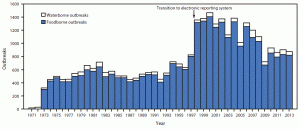This isn’t the detailed overview, but the annual overall snapshot of food and waterborne illness in the U.S.
 My favorite part has always been the second figure. To avoid foodborne illness, move to Texas. That hasn’t changed since 1973.
My favorite part has always been the second figure. To avoid foodborne illness, move to Texas. That hasn’t changed since 1973.
All it means is, cowboys and girls don’t look too hard.
It’s just a little barfing – get over it
Foodborne Disease Outbreaks
During 1973–2013, the U.S. Centers for Disease Control (CDC) received reports of 30,251 foodborne disease outbreaks with 742,945 outbreak-associated illnesses from the 50 states, Puerto Rico, the District of Columbia, and freely associated states/territories. An average of 738 (range: 298–1,404) outbreaks were reported each year.
The average annual number of foodborne disease outbreaks reported to CDC increased in 1998 in comparison to previous years, coinciding with the transition to an electronic reporting system, and decreased in 2009 in comparison to 1998–2008 coinciding with the transition to reporting through NORS (FDOSS and WBDOSS share an enhanced reporting platform, the National Outbreak Reporting System (NORS) (http://www.cdc.gov/nors). NORS also collects information on disease outbreaks with modes of transmission other than food and water, including person-to-person contact, animal contact, and environmental contamination.)
In 2013, a total of 792 single-state exposure outbreaks were reported with 11,786 illnesses by 47 states and Puerto Rico (Table) (Figure 2); an additional 26 multistate outbreaks (i.e., exposure to the implicated food occurred in more than one state) with 1,530 associated illnesses also were reported. CDC periodically publishes more detailed annual summaries describing the implicated foods, etiologic agents, settings, and points of contamination associated with foodborne disease outbreaks (http://www.cdc.gov/foodsafety/fdoss/data/annual-summaries/index.html).
Waterborne Disease Outbreaks
During 1971–2013, CDC received reports of 1,957 waterborne disease outbreaks with 642,782 outbreak-associated illnesses from 50 states and six freely associated states/territories. An average of 46 waterborne outbreaks was reported each year (Figure 1). In 2013, a total of 55 outbreaks causing at least 2,824 illnesses occurred in 21 states. No multistate outbreaks were reported; waterborne disease outbreak data for 2013 are preliminary (Table) (Figure 3). CDC periodically publishes more detailed summaries of waterborne disease outbreaks associated with recreational water and of waterborne disease outbreaks associated with drinking water (http://www.cdc.gov/healthywater/surveillance/surveillance-reports.html).
 Reported outbreaks represent only a small fraction of all foodborne and waterborne illnesses that occur each year and the outbreak data reported here are subject to limitations. Outbreaks caused by certain pathogens or vehicles might be more likely to be recognized, investigated, or reported. Some illnesses reported as sporadic (i.e., not outbreak-associated) are likely not recognized as being part of a reported outbreak or might be part of an undetected outbreak. In addition, all outbreak-related illnesses might not be identified during an investigation, smaller outbreaks might not come to the attention of public health authorities, and some outbreaks might not be investigated or reported to CDC.
Reported outbreaks represent only a small fraction of all foodborne and waterborne illnesses that occur each year and the outbreak data reported here are subject to limitations. Outbreaks caused by certain pathogens or vehicles might be more likely to be recognized, investigated, or reported. Some illnesses reported as sporadic (i.e., not outbreak-associated) are likely not recognized as being part of a reported outbreak or might be part of an undetected outbreak. In addition, all outbreak-related illnesses might not be identified during an investigation, smaller outbreaks might not come to the attention of public health authorities, and some outbreaks might not be investigated or reported to CDC.
Reporting practices for foodborne and waterborne disease outbreaks vary among states and territories, which might have differing definitions or interpretations of which events are reportable and unique laws related to disease outbreak reporting. Thus, variations in reporting rates by state or territory might reflect variations in levels of effort and funding for foodborne and waterborne disease outbreak investigation, rather than true differences in outbreak incidence rates by state. NORS maintains a dynamic database; this report includes data available on May 1, 2015, for foodborne disease outbreaks and May 4, 2015, for waterborne disease outbreaks; data published in this Summary might differ from those published earlier or later.
Foodborne disease outbreaks are defined as two or more cases of a similar illness resulting from ingestion of a common food. Waterborne disease outbreaks are defined as two or more cases of a similar illness linked epidemiologically by time and location to exposure to water or water-associated chemicals volatized into the air.
